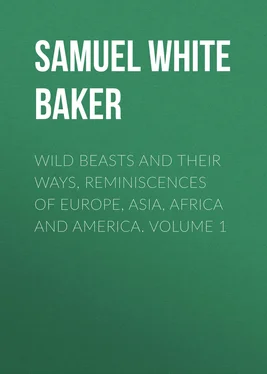Samuel White Baker - Wild Beasts and Their Ways, Reminiscences of Europe, Asia, Africa and America. Volume 1
Здесь есть возможность читать онлайн «Samuel White Baker - Wild Beasts and Their Ways, Reminiscences of Europe, Asia, Africa and America. Volume 1» — ознакомительный отрывок электронной книги совершенно бесплатно, а после прочтения отрывка купить полную версию. В некоторых случаях можно слушать аудио, скачать через торрент в формате fb2 и присутствует краткое содержание. Жанр: Путешествия и география, История, foreign_edu, foreign_antique, foreign_prose, на английском языке. Описание произведения, (предисловие) а так же отзывы посетителей доступны на портале библиотеки ЛибКат.
- Название:Wild Beasts and Their Ways, Reminiscences of Europe, Asia, Africa and America. Volume 1
- Автор:
- Жанр:
- Год:неизвестен
- ISBN:нет данных
- Рейтинг книги:3 / 5. Голосов: 1
-
Избранное:Добавить в избранное
- Отзывы:
-
Ваша оценка:
- 60
- 1
- 2
- 3
- 4
- 5
Wild Beasts and Their Ways, Reminiscences of Europe, Asia, Africa and America. Volume 1: краткое содержание, описание и аннотация
Предлагаем к чтению аннотацию, описание, краткое содержание или предисловие (зависит от того, что написал сам автор книги «Wild Beasts and Their Ways, Reminiscences of Europe, Asia, Africa and America. Volume 1»). Если вы не нашли необходимую информацию о книге — напишите в комментариях, мы постараемся отыскать её.
Wild Beasts and Their Ways, Reminiscences of Europe, Asia, Africa and America. Volume 1 — читать онлайн ознакомительный отрывок
Ниже представлен текст книги, разбитый по страницам. Система сохранения места последней прочитанной страницы, позволяет с удобством читать онлайн бесплатно книгу «Wild Beasts and Their Ways, Reminiscences of Europe, Asia, Africa and America. Volume 1», без необходимости каждый раз заново искать на чём Вы остановились. Поставьте закладку, и сможете в любой момент перейти на страницу, на которой закончили чтение.
Интервал:
Закладка:
There was no hole whatever in that tiger. The bullet having entered the nostril, broken the neck, and run along the body, the animal consequently had never moved. The first shot, when obscured in thick jungle, had probably deflected from the interposing reeds–at all events it missed. This tiger, when laid out straight, but without being pulled to increase its length, measured exactly 9 feet 8 inches from nose to tail.
CHAPTER III
The foregoing chapter is sufficient to explain the ferocity of the male elephant at certain seasons which periodically affect the nervous system. It would be easy to multiply examples of this cerebral excitement, but such repetitions are unnecessary. The fact remains that the sexes differ materially in character, and that for general purposes the female is preferred in a domesticated state, although the male tusker is far more powerful, and when thoroughly trustworthy is capable of self-defence against attack, and of energy in work that would render it superior to the gentler but inferior female. (The female differs from other quadrupeds in the position of her teats, which are situated upon the breast between the fore legs. She is in the habit of caressing her calf with her trunk during the operation of suckling.)
It may be inferred that a grand specimen of a male elephant is of rare occurrence. A creature that combines perfection of form with a firm but amiable disposition, and is free from the timidity which unfortunately distinguishes the race, may be quite invaluable to any resident in India. The actual monetary value of an elephant must of necessity be impossible to decide, as it must depend upon the requirements of the purchaser and the depth of his pocket. Elephants differ in price as much as horses, and the princes of India exhibit profuse liberality in paying large sums for animals that approach their standard of perfection.
The handsomest elephant that I have ever seen in India belongs to the Rajah of Nandgaon, in the district bordering upon Reipore. I saw this splendid specimen among twenty others at the Durbar of the Chief Commissioner of the Central Provinces in December 1887, and it completely eclipsed all others both in size and perfection of points. The word "points" is inappropriate when applied to the distinguishing features of an elephant, as anything approaching the angular would be considered a blemish. An Indian elephant to be perfect should be 9 feet 6 inches in perpendicular height at the shoulder. The head should be majestic in general character, as large as possible,—especially broad across the forehead, and well rounded. The boss or prominence above the trunk should be solid and decided, mottled with flesh-coloured spots; these ought to continue upon the cheeks, and for about three feet down the trunk. This should be immensely massive; and when the elephant stands at ease, the trunk ought to touch the ground when the tip is slightly curled. The skin of the face should be soft to the touch, and there must be no indentations or bony hollows, which are generally the sign of age. The ears should be large, the edges free from inequalities or rents, and above all they ought to be smooth, as though they had been carefully ironed. When an elephant is old, the top of the ear curls, and this symptom increases with advancing years. The eyes should be large and clear, the favourite colour a bright hazel. The tusks ought to be as thick as possible, free from cracks, gracefully curved, very slightly to the right and left, and projecting not less than three feet from the lips. The body should be well rounded, without a sign of any rib. The shoulders must be massive with projecting muscular development; the back very slightly arched, and not sloping too suddenly towards the tail, which should be set up tolerably high. This ought to be thick and long, the end well furnished with a double fringe of very long thick hairs or whalebone-looking bristles. The legs should be short in proportion to the height of the animal, but immensely thick, and the upper- portion above the knee ought to exhibit enormous muscle. The knees should be well rounded, and the feet be exactly equal to half the perpendicular height of the elephant when measured in their circumference, the weight pressing upon them whilst standing.
The skin generally ought to be soft and pliable, by no means tight or strained, but lying easily upon the limbs and body.
An elephant which possesses this physical development should be equal in the various points of character that are necessary to a highly-trained animal.
When ordered to kneel, it should obey instantly, and remain patiently upon the ground until permitted to rise from this uneasy posture. In reality the elephant does not actually kneel upon its fore knees, but only upon those of the hinder legs, while it pushes its fore legs forward and rests its tusks upon the ground. This is a most unnatural position, and is exceedingly irksome. Some elephants are very impatient, and they will rise suddenly without orders while the ladder is placed against their side for mounting. Upon one occasion a badly-trained animal jumped up so suddenly that Lady Baker, who had already mounted, was thrown off on one side, while I, who was just on the top of the ladder, was thrown down violently upon the other. A badly-tutored elephant is exceedingly dangerous, as such vagaries are upon so large a scale that a fall is serious, especially should the ground be stony.
A calm and placid nature free from all timidity is essential. Elephants are apt to take sudden fright at peculiar sounds and sights. In travelling through a jungle path it is impossible to foretell what animals may be encountered on the route. Some elephants will turn suddenly round and bolt, upon the unexpected crash of a wild animal startled in the forest. The scent or, still worse, the roar of a bear within 50 yards of the road will scare some elephants to an extent that will make them most difficult of control. The danger may be imagined should an elephant absolutely run away with his rider in a dense forest; if the unfortunate person should be in a howdah he would probably be swept off and killed by the intervening branches, or torn to shreds by the tangled thorns, many of which are armed with steel-like hooks.
It is impossible to train all elephants alike, and very few can be rendered thoroughly trustworthy; the character must be born in them if they are to approach perfection.
Our present perfect example should be quite impassive, and should take no apparent notice of anything, but obey his mahout with the regularity of a machine. No noise should disturb the nerves, no sight terrify, no attack for one moment shake the courage; even the crackling of fire should be unheeded, although the sound of high grass blazing and exploding before the advancing line of fire tries the nerves of elephants more than any other danger.
An elephant should march with an easy swinging pace at the rate of 5 miles an hour, or even 6 miles within that time upon a good flat road. As a rule, the females have an easier pace than the large males. When the order to stop is given, instead of hesitating, the elephant should instantly obey, remaining rigidly still without swinging the head or flapping the ears, which is its inveterate and annoying habit. The well-trained animal should then move backward or forward, either one or several paces, at a sign from the mahout, and then at once become as rigid as a rock.
Should the elephant be near a tiger, it will generally know the position of the enemy by its keen sense of smell. If the tiger should suddenly charge from some dense covert with the usual short but loud roars, the elephant ought to remain absolutely still to receive the onset, and to permit a steady aim from the person in the howdah. This is a very rare qualification, but most necessary in a good shikar elephant. Some tuskers will attack the tiger, which is nearly as bad a fault as running in the opposite direction; but the generality, even if tolerably steady, will swing suddenly upon one side, and thus interrupt the steadiness of aim.
Читать дальшеИнтервал:
Закладка:
Похожие книги на «Wild Beasts and Their Ways, Reminiscences of Europe, Asia, Africa and America. Volume 1»
Представляем Вашему вниманию похожие книги на «Wild Beasts and Their Ways, Reminiscences of Europe, Asia, Africa and America. Volume 1» списком для выбора. Мы отобрали схожую по названию и смыслу литературу в надежде предоставить читателям больше вариантов отыскать новые, интересные, ещё непрочитанные произведения.
Обсуждение, отзывы о книге «Wild Beasts and Their Ways, Reminiscences of Europe, Asia, Africa and America. Volume 1» и просто собственные мнения читателей. Оставьте ваши комментарии, напишите, что Вы думаете о произведении, его смысле или главных героях. Укажите что конкретно понравилось, а что нет, и почему Вы так считаете.












